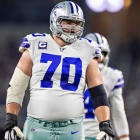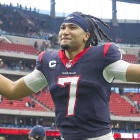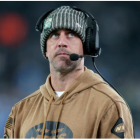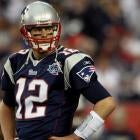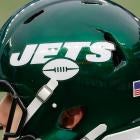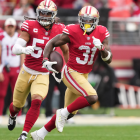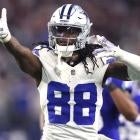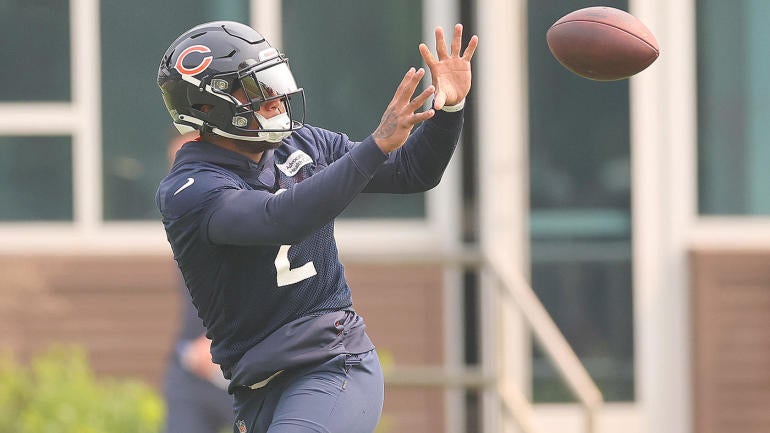
In the modern NFL, offense is more determinative of team success than defense. That's just the way it is -- even after defenses leaguewide fought back last season and drove scoring down a bit for the first time in a while.
Because we know exactly how important offense is, we thought we'd take this time to identify the person -- be it a player, coach or executive -- who will be each team's offensive X-factor for the 2023 season. Who is the guy whose performance or decisions or role will be key in determining exactly how much success each team is able to have?
That's what we're looking to find. Here they are:
Arizona Cardinals: GM Monti Ossenfort
Arizona's offensive depth chart is ... not pretty. Ossenfort will likely be the one making the final decision on when, if at all, Kyler Murray returns to the field after suffering a torn ACL last December. There is nothing more likely to have a larger effect on the team's offense than that specific decision, so Ossenfort looms as by far the biggest X-factor for this season. If Murray comes back, it's possible the offense approaches competence whenever he can reach full health. If he doesn't ... the Cards are likely looking at the No. 1 pick in the draft.
Atlanta Falcons: QB Desmond Ridder
The Falcons bypassed the quarterback position in both free agency and the draft this offseason, electing instead to move forward with their 2022 third-round pick under center. Ridder completed 73 of 115 passes (63.5%) for 708 yards (6.2 per attempt) and two touchdowns (with zero interceptions) across four starts last season. Those numbers don't exactly scream future star, but we all know that rookie performance isn't necessarily directly indicative of how a player will perform in the future. Atlanta seems confident in Ridder, and has surrounded him with high-level playmakers at tight end (Kyle Pitts), wide receiver (Drake London) and running back (Bijan Robinson) in the last three drafts, and still has Arthur Smith scheming things up. Can Ridder take advantage? That will determine most of Atlanta's degree of offensive success in 2023.
Baltimore Ravens: OC Todd Monken
I mean, the Ravens basically told us this was their X-factor when they made the move to fire longtime coordinator Greg Roman and hire Monken in his stead. Monken is charged with opening up and modernizing the passing-game concepts to complement the diverse, efficient run game the Ravens have built since Lamar Jackson assumed the starting job. He'll have help in the form of Odell Beckham Jr., Nelson Agholor and Zay Flowers joining the receiving corps, but the concepts need to put Jackson in far better position to succeed than the ones that the Ravens have been utilizing over the past few years. And that's on Monken.
Buffalo Bills: WR Gabe Davis
Davis was expected to take a huge step forward as Buffalo's No. 2 receiver behind Stefon Diggs last season. In the Week 1 game against the Rams, he shined, hauling in four catches for 88 yards and a touchdown. But he also got injured during that game, missed Week 2, and then never really got on track the rest of the year. He ended up playing a career-high 91% of the team's offensive snaps, but saw his catch rate hit a career-low 51.6% as he hauled in 48 catches for 836 yards and seven scores. Now healthy and headed into Year 4 of his NFL career, can Davis become a true No. 2? We're about to find out.
Carolina Panthers: The pass-catchers
In trading up to acquire the No. 1 overall pick that was used to select Bryce Young, the Panthers surrendered their No. 1 wide receiver, D.J. Moore. This offseason, they brought in Adam Thielen and D.J. Chark to complement incumbent wideouts Terrace Marshall and Laviska Shenault, and then they drafted Jonathan Mingo in the second round. At tight end, they signed Hayden Hurst to work with Ian Thomas and Tommy Tremble at tight end. With Frank Reich calling plays and a strong offensive line, the potential is there for Young to hit the ground running. That is, if the aforementioned group of players can be a league-average (or better) pass-catching group. But if the talent does not measure up and Young is left throwing into tight windows all the time, he's likely to struggle.
Chicago Bears: WR D.J. Moore
Speaking of Moore ... Chicago is clearly hoping that he can do for Justin Fields what Stefon Diggs did for Josh Allen and Ja'Marr Chase did for Joe Burrow and A.J. Brown did for Jalen Hurts. Moore doesn't necessarily have the pedigree of those other receivers, but before last season he had managed three 1,000-yard campaigns in a row despite some pretty awful quarterback play in Carolina. He's also just 26 years old and has shown the ability to succeed in the slot and out wide, and as both a possession receiver and a guy who can take the top off the defense. Every quarterback needs a No. 1 target, and Moore should be just that for Fields.
Cincinnati Bengals: LT Orlando Brown
The Bengals spent a whole bunch of money last offseason to remake their offensive line. They shelled out to bring in Alex Cappa, Ted Karras and La'el Collins. At first, the plan was not working all that well. But things improved over the second half of the season, up until injuries depleted the line and the unit struggled against the eventual champion Chiefs in the playoffs. With Collins likely out for a while, the Bengals are shifting incumbent left tackle Jonah Williams over to the right side, and brought in Brown (signing him away from the Chiefs) to play on the left. The contract they gave Brown was widely seen as a discount compared to his expected market, and if he can be even a league-average left tackle for them, their line will be better for it. And as we have seen in the past, he has the potential to be more than that. If the line can turn into an outright strength for Cincinnati, it has the potential to raise the ceiling of the offense even higher than it already is.
Cleveland Browns: QB Deshaun Watson
Watson was downright awful last season after returning from a suspension for violating the league's personal conduct policy when he was accused by more than 20 women of sexual misconduct. The Browns' entire future essentially hinges on whether he recaptures the form that made the team willing to sacrifice so much in the first place in exchange for a player who had been accused of such heinous acts.
Dallas Cowboys: WR Brandin Cooks
Last offseason, the Cowboys cut ties with Amari Cooper. Whether it was because they thought he was overpaid or because of personality and chemistry differences, it did not work out. Dallas basically had CeeDee Lamb and then A Bunch of Guys at wide receiver. Michael Gallup was not himself coming back from a torn ACL. James Washington wasn't going to be the solution, but he broke his foot in training camp anyway. Third-round pick Jalen Tolbert was a non-factor. Noah Brown ended up being the team's second-best receiver until T.Y. Hilton was signed off the street. Enter Cooks, who the Cowboys acquired for a ludicrously low price even while getting the Texans to take on some of his contract. Giving the team a real No. 2 wideout across from Lamb -- especially one who has deep speed -- should open things up considerably for an offense that needs to figure out a way to keep opposing defenses from condensing the field on it in big games.
Denver Broncos: HC Sean Payton
The big question here is whether Russell Wilson can bounce back, or if what we've seen from him over the past two seasons is the new normal. Nobody will have a greater effect on the answer to that question than Payton. Will he be able to get Russ to change his style of play, and go with the flow of the system? If not, the Broncos might be looking for a new quarterback as soon as next offseason.
Detroit Lions: Outside WRs
The Lions have one of the NFL's best offensive lines. They have a very good play-caller in Ben Johnson, who was a highly sought-after head-coaching candidate this offseason but decided to return to Detroit. They have a premier slot receiver in Amon-Ra St. Brown. They have two quality backs who bring different things to the table in David Montgomery and Jahmyr Gibbs. But where is the perimeter threat on this offense? With Jameson Williams suspended for the first six games of the season, the starting outside wide receivers might be Marvin Jones and Josh Reynolds, which isn't much of an improvement of what the team had last year. The Lions seem like the most fun DeAndre Hopkins destination for exactly this reason. Unless they bring him in and/or Williams is a stud right away, the Lions are going to have to get creative in scheming around this issue.
Green Bay Packers: QB Jordan Love
We all know what happened the last time a late first-round pick sat for three years and then stepped into the lineup to replace a living legend who had an acrimonious divorce from the Packers. That player himself became a living legend and in time repeated the exact same cycle in almost exactly the same way. If Jordan Love comes anywhere close to replicating Aaron Rodgers' career path, the Packers will be over the moon. The first step is to just be a competent or better starter, though, and earn himself another year in the role. With one of the league's youngest and least-experienced skill position corps, there's going to be a lot of pressure on Love to deliver the results on the strength of his own talent right away.
Houston Texans: OC Bobby Slowik
The Texans hired DeMeco Ryans as their head coach this offseason, and Ryans brought Slowik with him from San Francisco to Houston. As the passing-game coordinator for the 49ers, he was in charge of helping Kyle Shanahan marry his diverse run game to the pass, and he'll have to bring that bag of tricks to the Texans. With Houston not having nearly the same pass-catching (or offensive line) talent that the Niners have, it will be a challenge for Slowik to replicate that success. But other Shanahan-system coordinators have been able to get pretty good results outside of San Francisco, so it's certainly not an impossible task. We're about to see if he and the Texans are up for it.
Indianapolis Colts: QB Anthony Richardson
Richardson is a one-of-a-kind athlete, one of the most unique players ever to enter the league. How he's able to make the transition to the NFL, and how immediately he's able to translate that athleticism into production -- whether on the ground or through the air -- is the single-most important factor for the Colts' offense this season.
Jacksonville Jaguars: WR Calvin Ridley
The Jaguars took a significant step forward last season in their first year under Frank Reich. Under Urban Meyer in 2021, the Jags were one of the league's most inept offenses: They finished the season ranked 27th in yards, 32nd in points, 29th in expected points added per play and 27th in Football Outsiders' DVOA. Last season under Doug Pederson, those numbers improved across the board, as Jacksonville checked in 10th in both yards and points, tied for seventh in EPA per play, and ninth in DVOA. Now, the Jaguars are dropping a true No. 1 wide receiver into the mix. Can they become even more efficient, even more explosive? Can Trevor Lawrence take his game to a new level? How Ridley handles his return to the league after an extended absence will play a significant role in answering those question.
Kansas City Chiefs: OTs Donovan Smith and Jawaan Taylor
As previously mentioned, the Bengals signed Orlando Brown away from the Chiefs. They only did so after Kansas City signed Jawaan Taylor to a big free-agent deal, but Kansas City then also added Smith to the mix. It sounded initially like Taylor might be moving from right tackle to left, but in the wake of the Smith deal, he might be staying where he's spent the majority of his career, with Smith taking up residence on Patrick Mahomes' blind side. If that's the case, that's a lot of faith to put in a player coming off of what was likely his worst NFL season. Protecting Tom Brady is obviously a lot different than protecting Mahomes, but if Smith just doesn't have it anymore, it could cause the Chiefs to do a bunch of shuffling up front. And that's not ideal.
Los Angeles Chargers: OC Kellen Moore
Moore is here to help the Chargers open things up offensively. Too often under previous coordinator Joe Lombardi, the Chargers were operating in tight spaces. A player with a cannon attached to his shoulder like Justin Herbert should never rank 31st out of 33 qualifying quarterbacks in air yards per attempt, like Herbert did last year, according to Tru Media. Moore's Cowboys offenses were much more willing to test the opposition down the field, and if Moore can nudge Herbert in that direction and get him to be a bit more aggressive overall, it will go a long way toward finally getting the Football Internet's favorite tease of a team to fulfill its potential.
Los Angeles Rams: QB Matthew Stafford's elbow
Is Stafford fully healthy? If he's not, not much else matters for this offense. We saw last year how badly the team broke down amid various injuries -- to Stafford, to Cooper Kupp, to seemingly every offensive lineman -- but there is really only one player it cannot operate without. And as special a receiving threat as Kupp is, that player is Stafford.
Las Vegas Raiders: QB Jimmy Garoppolo
The revelation of a clause in Garoppolo's contract that allows the Raiders to release him with no financial penalty in the wake of his offseason foot surgery certainly raised our eyebrows. The Raiders are counting on Jimmy G delivering similar results to those he achieved in San Francisco, but without the cocoon of Kyle Shanahan, the scheme and the same plethora of weapons around him. (Davante Adams is there, but the rest of the pass-catchers aren't of the same quality.) If his foot isn't healthy or if he can't generate the same level of play without Shanahan in his ear and scheming things up, it's going to be a long season in the desert.
Miami Dolphins: The offensive line
Last season, head coach Mike McDaniel was able to successfully scheme around the almost total lack of quality offensive line play and build one of the most efficient and explosive passing offenses in the NFL -- particularly in the weeks where Tua Tagovailoa was healthy. Miami checked in fourth in Football Outsiders' pass offense DVOA and fifth in Tru Media's version of passing EPA per play, while no qualified quarterback had a higher rate of explosive gains per dropback than did Tagovailoa. Miami's running game was comparatively off-kilter, though, and it particularly struggled in "and-short" situations, finishing 30th in the NFL with a 56% conversion rate on third or fourth down with two or fewer yards to go, per Football Outsiders. The line is the key to both improving in those situations and to keeping Tua upright, and it needs to take a step forward this year.
Minnesota Vikings: WR Jordan Addison
You can easily make an argument for Alexander Mattison here given that he will be stepping into the shoes previously filled for quite a while by Dalvin Cook. But NFL offenses tend to go as far as their passing game can take them, and Addison is the player in the best position to help take that facet of Minnesota's offense to the next level. He doesn't have great size or elite speed, but Addison is a master technician able to generate separation from nearly any defensive back with ease. How well he works as a complement to Justin Jefferson and T.J. Hockenson will likely determine the ceiling of this offense.
New England Patriots: OC Bill O'Brien
There was perhaps no offense in football more broken last year than that of the Patriots under Matt Patricia. O'Brien should at least restore competence to the proceedings, but can he deliver more than that?
New Orleans Saints: WR Michael Thomas
Thomas has missed almost all of the past three seasons due to various lower-body injuries. The last time we saw him play a full season, he led the league in receiving yards (1,725) and set a new single-season record for receptions (149). The Saints did not have much in the way of passing-game threats for the first two years without Thomas, but Chris Olave emerged as a No. 1-caliber option last year. Can Thomas recapture his form and become a quality No. 2? If so, that makes the Saints look like a much different offense.
New York Giants: TE Darren Waller
That the Giants were able to craft even a remotely efficient offense last season with their paucity of passing-game weapons was a pretty incredible feat accomplished by Brian Daboll and Mike Kafka. Being able to do it again was going to be extremely difficult, so they at least tried to make moderate upgrades to the skill-position corps. Waller was the biggest swing among the group as he's only two years removed from having gone 90-1145-3 and 107-1196-9 in back-to-back seasons. He's only played 20 of 34 games over the past two years, though, and combined for 83 receptions for 1,053 yards and five touchdowns during that time. And he'll turn 31 years old early in the season. How much is left in the tank will determine whether he can be a true alpha passing option for Daniel Jones, which the Giants probably need him to be.
New York Jets: RB Breece Hall
Hall looked like he was fully breaking out as a star early last season, only to tear his ACL in Week 7. In his final three-plus games, Hall carried 59 times for 351 yards (5.95 per carry) and four touchdowns, while adding six receptions for an additional 117 yards. While the Jets did sign star free agent Dalvin Cook, he's 28 and will be better off having Hall mixed in throughout the game. Both players are ideal in the style of offense New York is using; it's important to have a back who can make just one cut, hit the crease and take off toward the end zone. (We've also seen how important that threat can be to Aaron Rodgers' success over these past few years.)
Philadelphia Eagles: OC Brian Johnson
In 2021, the Eagles' offense took off when then-new head coach Nick Sirianni gave up play-calling duties to focus more on holistic game management, allowing Shane Steichen to take over. The pivot to a run-heavy attack allowed the Eagles to build an efficient offense, which propelled them to the playoffs. Last year, Steichen helped Jalen Hurts evolve as a passer, and the offense hit even higher heights. Johnson was the quarterbacks coach during that run, and he obviously played a significant role in Hurts' development. Now, though, he's the coordinator and the play-caller. And that's a new wrinkle. If he hits the ground running, things will run smoothly. If not, there may be some kinks to work out throughout the season.
Pittsburgh Steelers: QB Kenny Pickett
Pickett had an up-and-down rookie season that saw him complete 63% of his passes at an average of just 6.2 yards per attempt, with seven touchdowns against nine interceptions. He improved over the second half of the year as the Steelers somehow once again rallied to finish with a winning record, but he still didn't show much of a ceiling as a passer. The future of Pittsburgh's offense depends on Pickett being able to access a higher level of playmaking both inside and outside the pocket, and being able to push the ball downfield to create big plays.
Seattle Seahawks: WR Jaxon Smith-Njigba
Seattle had one of the best 1-2 punches at wide receiver in the league last year, with DK Metcalf and Tyler Lockett helping Geno Smith have by far the best season of his career. The Seahawks have been lacking that true slot threat to diversify the offense, though, and that's where JSN fits in. He has ridiculous agility, and his feel for finding the soft spots of underneath coverage is elite. Unfortunately, he underwent surgery to repair a broken wrist suffered in Week 2 of the preseason. The hope is he will be back on the field sooner than later.
Geno has shown he can fire the ball down the field and into tight windows; giving him easier answers on the occasions where those throws are not there should help the Seahawks' offense function at as high a level as possible throughout the year.
San Francisco 49ers: [Insert QB Here]
We still don't know who will be under center for this team. Brock Purdy is coming back from elbow surgery. Trey Lance is reportedly recovered from his broken ankle, but we also haven't really seen that much of him during his two NFL seasons. The third quarterback, if both of those guys can't play, is Sam Darnold. Who is taking the snaps for the Niners -- and how healthy that player is -- might be the biggest wild card in the entire NFC.
Tampa Bay Buccaneers: QB Baker Mayfield
The downgrade from Tom Brady is, uh, a significant one. The Bucs offense already took a large step backward last season. Can Mayfield avoid taking the offense into the tank, or will he look a lot like the player he's been every year after his very good rookie season? Considering the (lack of) strength of this offensive line, the latter seems more likely.
Tennessee Titans: WR Treylon Burks
Tennessee's offense is based almost entirely around Derrick Henry. But the big man is 29 years old now, and turning 30 late in this season. He has 300-plus carries in three of the last four years, including 349 last year. After hitting 5.1 and 5.4 yards per carry in 2019 and 2020, respectively, he's been at 4.3 and 4.4 per carry the past two years. The Titans need a quality passing-game option to emerge, and Burks is their best shot at that happening. Burks suffered an LCL sprain and will be sidelined to open the season.
Washington Commanders: OC Eric Bieniemy
Bieniemy has coordinated the league's best offense for the past five years. He no longer has Patrick Mahomes and Andy Reid to count on, but there is some talent on hand in Washington. How much can he get out of it? And can he use whatever he does get as a springboard to finally getting the head-coaching opportunity he long since should have been offered?











